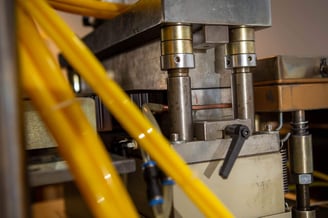Custom Thermoform Trays for ESD Protection

Electrostatic discharge (ESD) poses a significant threat to sensitive electronic components, often resulting in irreversible damage and costly product losses.
To minimize these risks and ensure the safe transportation of ESD-sensitive items, ESD thermoformed plastic trays have emerged as an ideal solution. These trays are specifically designed to provide a reliable electrostatic barrier, safeguarding delicate electronics from the harmful effects of ESD while maintaining the convenience and durability of thermoformed plastic construction.
As a result, businesses can achieve enhanced protection and efficiency in handling their vital electronic assets.
What is ESD?
Electrostatic Discharge, or ESD, is a brief electric current that happens when two objects with different electrical potentials come into contact and then separate. This causes the rapid transfer of electrostatic charge, generating high voltages that can wreak havoc on electronic devices and sensitive equipment.
ESD poses a major threat to electronics, potentially causing catastrophic failure or latent defects that might not be immediately apparent but can shorten product lifespan significantly.
What industries and items commonly need protection from ESD?
Components sensitive to electrostatic discharge (ESD), such as electronic components, medical devices, and aerospace and automotive parts, need to be protected from ESD to avoid damaging their internal circuitry.
Electronics: Shielding Vital Components
Electronic components like microchips, transistors, motherboards, hard drives, RAM modules, graphic cards, and processors face the risk of ESD damage. Their intricate structures make them highly susceptible to the high-voltage electric currents generated by ESD. Peripheral devices like keyboards, mice, and USB devices also need proper protection to prevent ESD-related damage during storage or shipment. Custom ESD plastic trays offer a safe and reliable way to store and transport these vulnerable components.
Medical Devices: Preserving Life-Saving Equipment
ESD protection is essential for medical devices, including pacemakers, monitoring systems, and diagnostic instruments. These devices contain electronic circuits that can be damaged by ESD, which may lead to malfunctions with potentially life-threatening consequences.
Aerospace and Automotive: Securing Safety
In the aerospace and automotive sectors, ESD plastic trays can play a crucial role in protecting essential components such as sensor systems, navigation equipment, and engine control units. A malfunction in these parts due to ESD can result in severe safety risks.
Telecommunications: Ensuring Equipment Stays Operational
Routers, modems, and switches are the backbone of networking and telecommunication systems. Their sophisticated circuitry can easily be damaged by ESD, making it wise to store and ship them with proper ESD protection in place.
Industrial Automation Components
ESD-sensitive components, like programmable logic controllers (PLCs), sensors, and drives, are integral parts of automation and control systems in various industries. The substantial costs associated with their failure make it necessary to store and transport these components using ESD-safe packaging.
How to protect from ESD?
In order to protect sensitive components from ESD, you can use ESD protective devices and materials, work in ESD-safe environments, and supplement equipment with proper education and training.
Through the Use of ESD Protective Devices and Materials
When looking to safeguard sensitive items from electrostatic discharge (ESD), consider custom thermoform trays made of ESD plastic. These trays are specifically designed to dissipate static charges across their surface.
Keep in mind the pricing is higher compared to standard HIPS material thermoformed plastic trays are typically made from. However, in sensitive applications, the potential headaches eliminated by ESD-safe plastic trays may be more than worth the investment.
ESD Safe Work Environments
Another key approach to mitigating ESD risks is by establishing an ESD-safe work environment. This includes using ESD-safe flooring, workstations, clothing, and tools, which all contribute to reducing the likelihood of ESD-related incidents.
Education and Training
Ensuring all personnel are well-informed and adequately trained on ESD awareness and handling procedures can significantly decrease ESD-related issues. Implement training programs that teach employees the proper techniques for handling ESD-sensitive items, like packing, unpacking, and transporting these goods.
What packaging materials don’t offer ESD protection?
Standard Plastic and Styrofoam
Common plastics and styrofoam aren't your best bet when it comes to ESD protection. They can generate a significant amount of static electricity, posing a risk to any ESD-sensitive items they touch. Avoid using these materials to prevent potential ESD damage.
Cardboard and Paper-based Packaging
Despite their popularity, affordability, and easy disposal, cardboard and paper-based materials fall short in ESD protection. They can accumulate and transfer static charges, upping the chances of ESD-related issues.
Non-ESD Treated Foam and Bubble Wrap
Regular foam and bubble wrap might seem like a good idea, but unless specifically treated for ESD, they won't protect your electronics. Friction between these materials and sensitive components can create static electricity, putting your items at risk. Always opt for ESD-treated foam and bubble wrap to ensure the safety of your electronic devices.
Get Started with ESD plastic trays from Ready-Made today
If you’re looking for ESD-resistant plastic trays for sensitive electronics or components, explore our custom tray solutions or contact us to speak with an expert!




